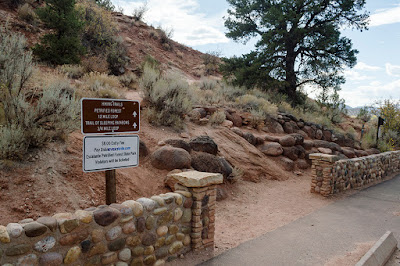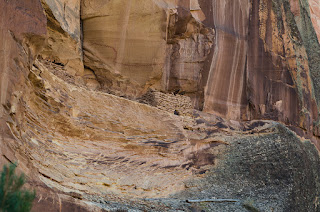The Trail
This moderate trail is about 2.2 miles round trip with a 250 foot elevation change. However, there is about twice as much climbing as the overall elevation change indicates due to the up-and-down nature of the trail. When I did this trail, I went counterclockwise around both loops, staying right at the intersections all the way through, so that is the approach shown on the graph and other information below. This is also the direction that hikers following the points of interest explained on the nature trail guide available to borrow at the trailhead.
 |
Topographical Map
|
 |
Graph of Elevation
|
 |
Trail in Google Earth
|
This trail starts on the other side of a short stone wall next to the parking area. It heads uphill with the help of a few switchbacks for about a half mile before leaving off some.
 |
| Trailhead |
 |
Another entrance to the trail
|
A short ways from the trailhead is an interesting rock balanced awkwardly at the edge of a drop-off. It stays suspended in the air by a small section that has not eroded away like the rest of the material under it.
 |
Balanced Rock
|
Hikers will need to continue up through the pygmy forest and near the top of the hill before coming across any of the petrified wood that is abundant along this loop. A spattering of specimens lies along the sprawling landscape to the sides of the trail, but perhaps the most impressive along this section of path is a longer stretch of these fossils that appear to make up the broken segments of a once fallen tree.
 |
Stretch of petrified wood segments
|
Right next to this line of petrified wood the path splits. In order to continue along the Trail of Sleeping Rainbows, stay straight as shown in the sign. When you come to the next sign, stay right to continue around the loop in a counter-clockwise direction. This trail descends down sharply, levels out some at the bottom near an overlook of the wash below, and then ascends back up an equally steep section before heading back to the main Petrified Forest Trail.
 |
Trail Split
|
While The Trail of Sleeping Rainbows is not part of the main trail and nothing along it is included in the Nature Trail Guide, there are far more petrified wood specimens here than on the other trail. These incredible fossils literally line the path, and huge pieces present themselves at nearly every turn. I believe the largest pieces of this wood-turned-to-rock are found along this section of the trail.
 |
View looking down in the wash at the
west-most point of the trail
|
 |
Very large pieces of petrified wood -
probably the largest I saw along the trail
|
 |
Side view of the largest piece of petrified wood
I spotted on this trail
|
 |
Heading back up the trail
|
After rejoining the main trail again, head right to continue that loop in a counter-clockwise direction. As you continue, enjoy the expansive views of the surrounding area. A sign post with the number twelve indicates the largest piece of petrified wood found along the Petrified Forest Trail (though there are larger specimens along The Trail of Sleeping Rainbows), and sign post 14 shows a remarkable specimen on which the tree rings are clearly recognizable.
 |
Largest piece of petrified wood along the
Petrified Forest Trail
|
 |
Remarkable Specimen on which the tree rings
are clearly visible
|
The trail ends where it starts after a descent along the same section of trail you came up. Enjoy nice views of Wide Hollow Reservoir and the surrounding area on your way back.
Either before you head up the trail, or after you get back, don't miss
checking out the very long petrified tree fossil just north of the
trailhead and parking lot!
 |
Long petrified tree near the trailhead
|
This trail is part of a state park and a fee is required to use the area. Restrooms are available as part of the park, but not directly at the trailhead. Leashed dogs are permitted on the trail as long as you clean up after them. This trail is under surveillance to help prevent theft of the rocks. Either way, please do not take anything with you from the park in order to leave it for others to also enjoy. (Furthermore, some say that a curse sticks with anyone who dares to steal the fossils from the area.)
Directions
This Garfield County trail is located only a couple of miles west from the center of Escalante, Utah. To get there, take Hwy 12 to Reservoir Rd. There is a clear brown recreation sign marking the turn off for "Escalante Petrified Forest State Park/Wide Hollow Reservoir." Turn north here and head past a rock shop and ranch land to reach the park. Stay right (away from the reservoir) where the road splits and head east a short ways to the parking area. GPS Coordinates: N37° 47.219' W111° 37.829'


























































